How To Grow Dryland Corn With Less Than 10 Inches Annual Precipitation
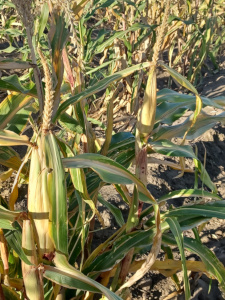

Drought Tolerant Corn Varieties
We focus on Hopi flour corn varieties because they are high in carbohydrates, store well, and they can be grown without irrigation in areas with less than 10" of annual precipitation. There are many more Pueblo corn varieties than those listed here. Here are the varieties we have tried and recommend.
- Hopi White - Flour corn, 5-6 feet tall, plant deeply, makes many tillers.
- Hopi Pink - Flour corn, 5-6 feet tall, makes many tillers.
- Hopi Blue - Soft flour corn, 5-7 feet tall, usually no ears on tillers.
- Smoik Hu:n - Early flour corn, 5-7 feet tall, tillers well.
- Concha White - Flour corn, 5-8 feet tall, tillers well, susceptible to corn smut.
- Wikti (Hopi Greasy Head) - Early flour corn, 4-5 feet tall, tillers well, susceptible to corn smut.
- Kikam Hu:n (Pima 60 Day Corn) - Early 80% flour 20% flint corn, very starchy.
- Hopi Turquoise - Flour corn, did not produce in strip-till planting test.
- Hopi Purple - Flour corn, did not produce in no-till dibbled planting test.
Hopi White is one of the best type for dry conditions and deep planting. Hopi Pink seems to be the most productive with up to 8 ears per plant, and ears can be very colorful. Hopi Blue makes very large dark ears with soft flour kernels that are easy to grind into flour and our favorite to harvest, as sweet corn, at the milk stage. Concha White plants can get really large with 8 full sized stalks per plant and up to 7 ears. Hopi and other pueblo corn varieties can survive without irrigation, but require much more space per plant to produce well even with irrigation.
Pueblo landrace corn varieties are older compared to commercial corn varieties can display a wide variety of unusual characteristics. Sometimes kernels are present on the tassel, ears may have a tassel on the end , and stalks can have ears at the terminal/top/tassel node, see the picture labeled "Hopi Pink / Ears On Tassel". It is likely that Teosinte, the wild ancestor of corn, produced ears with tassels on the terminal node as well as on lower lateral nodes, but as corn ears got bigger and heavier corn evolved to produce ears only on the lower lateral nodes. Heavy ears at the tops of the plants would increase the chances of lodging. The terminal node at the top of the plant became specialized to produce only pollen facilitating transport of pollen grains to the silk of lower lateral nodes.
Hopi Corn Precipitation Requirements
Hopi corn is traditionally grown in Arizona with less than 10 inches annual precipitation and little rain from April to the end of July. It can survive several months without precipitation. We grow Hopi corn in north central Washington with 10 inches of annual precipitation most of which is winter snow and almost no rain from mid June to mid September.
The Hopi reservation has no rain from April to the end of July so I looked up some numbers to compare. In both regions the dry period is 3 months long with the dry period in Okanogan being later in the year. The bulk of precipitation in Okanogan is in winter months in the form of snow. Monthly totals can be a little misleading since in Okanogan the table shows June and September has having about 1 inch of rain but last half of June and first half of September are usually dry. This year was unusual and we had 0.5 inches of rain on August 20th, but no more expected till October 20th. In Arizona the Hopi plant corn in mid April when soil the in Okanogan is still too cold for corn to germinate. I have successfully planted in late April and mid May but the time of emergence of the April planted corn was delayed and similar to the May planted corn.
Precipitation (Update Nov 25th 2024) - Rain finally started in November with a total of 4.3 inches between Oct 28 - Nov 25 2024. It is too cold to grow anything now but this rain partially recharges ground water reserves for next year's planting.
Monthly Avg. Precipitation & Hi / Lo Temperatures Last 10 Years | ||||
|---|---|---|---|---|
| Arizona | Okanogan | |||
| Precipitation | Temperature | Precipitation | Temperature | |
| January | 0.8 | 43°F / 27°F | 2.4 | 33°F / 21°F |
| February | 0.6 | 49°F / 30°F | 1.3 | 37°F / 22°F |
| March | 0.6 | 57°F / 36°F | 1.7 | 46°F / 30°F |
| April | 0.2 - dry | 67°F / 43°F | 1.1 | 57°F / 37°F |
| May | 0.3 - dry | 76°F / 51°F | 1.2 | 69°F / 45°F |
| June | 0.2 - dry | 88°F / 63°F | 0.8 - partly dry | 77°F / 51°F |
| July | 0.5 | 91°F / 70°F | 0.2 - dry | 87°F / 59°F |
| August | 0.7 | 89°F / 68°F | 0.3 - dry | 86°F / 58°F |
| September | 0.4 | 82°F / 60°F | 0.7 - partly dry | 75°F / 49°F |
| October | 0.5 | 68°F / 46°F | 1.6 | 58°F / 38°F |
| November | 0.5 | 55°F / 34°F | 2.2 | 42°F / 28°F |
| December | 0.7 | 44°F / 28°F | 2.5 | 32°F / 20°F |
When To Plant Hopi Corn?
Plant when soil temperatures at a depth of 8 inches is 50°F or higher. Since Hopi Corn is planted deeply it can be planted 2 weeks before the last expected frost date and it will emerge from the soil after that date. Planting earlier will not result in earlier emergence because cool soil temperatures will delay germination and increase the chances of seed spoilage. For us the ideal planting time is between April 20th and May 31st where last expected frost date is May 15th, though we had frost damage to corn outer leaves in mid June 2024. For early planted corn emergence is hopefully delayed by cool soil temperatures until after the last frost. Planting early also give us more time to get fields planted as. Planting late forces us to harvest corn before it is fully dried in the field.
How Many Days To Maturity For Hopi Corn?
Days to maturity can vary a little depending on the variety, but most Hopi corn varieties can be harvested at the milk stage to eat as sweet corn by 60-75 days. For saving seeds it takes 120 days or more before kernels are ready to harvest, and additional time may be needed to dry down before storage. If Hopi Corn is planted too closely harvest date will be delayed. If the corn is mature but not dry, bring it in before the first expected frost or seed will be damaged by the cold. In our area it is best to get all varieties planted before June 1st and harvest at the end of September or at latest around October 10th, before the first frost.
Planting Location - Where To Plant Hopi Corn?
Look at type and size of existing vegetation before clearing an area to plant. Rabbit brush and big sagebrush indicated the presence of ground moisture and healthier and bigger existing plants indicates more available ground moisture. Short grass that dies and turns brown early in summer indicates less available ground moisture and/or poor soil that may requires additional fertilizer. Hopi corn roots can extend up to 10 feet deep and 10 feet horizontally in search of nutrients and moisture. Ground water is closer to the surface on the lower side of slopes and areas that collect water during summer rains are good places to plant.
How to Clear for Planting Dryland Hopi Corn?
Clear the selected location of all vegetation to reduce competition for water. Clearing all vegetation and spacing hills far apart exposes the soil to erosion and damage by high winds. To mitigate this cultivate smaller fields of an acre or less, orient fields or strips of cultivated area perpendicular to prevailing winds, and leave natural vegetation or plant a dryland legume cover crop (like alfalfa) between fields. To reduce erosion space plants evenly and a distance less than three times their height. For Hopi corn choose a row of spacing 12 feet or less. Most of our fields are 80-100 feet wide but several hundred feet long.
How Far Apart to Plant Hopi Corn?
Suggested spacing for dryland Hopi corn is 12-25 sq. ft. per plant or 4-7 plants in hills 9-12 feet apart.
Please Click Here To Try Our New 2025 Corn Spacing & Yield Calculator
The root system of Hopi Corn extends horizontally much more than expected compared to other similar sized crop plants. Plant in hills 6-20 feet apart by making a hole and puting 7-10 seeds per hole. Lowering plant density reduces competition for ground water and is much more important than reducing evaporation by early canopy closure (close spacing). Plant deeply 6" or more and plant multiple seeds per hole to ensure enough seedlings emerge in each hill. These will be thinned later to 4-7 plants per hill. A single kernel can develop as many as 6 stalks (main stalk plus tillers) with as many as 8 ears of corn. In each hill stalks provide each other with protection from the sun, the wind, summer heat, and shield ears developing in the middle from animals. Each plant needs 12-25 square feet or more depending on conditions.
When Hopi Corn is planted too closely plants at the ends of rows do better than plants within the rows and outside rows do better than inside rows. In the experiment below Concha White was planted closely in a square to test the benefits of early canopy closure. The plants on the outside of the square had less competition for ground water, stayed green, and made ears while the corn in the middle dried out and did not produce ears.
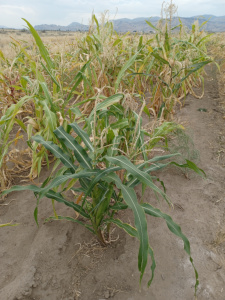
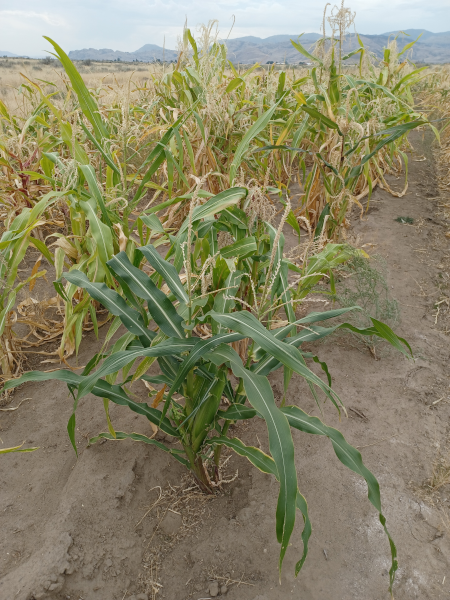
Hopi White / End Of Row 1
|
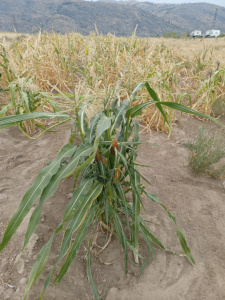

Hopi White / End Of Row 2
|

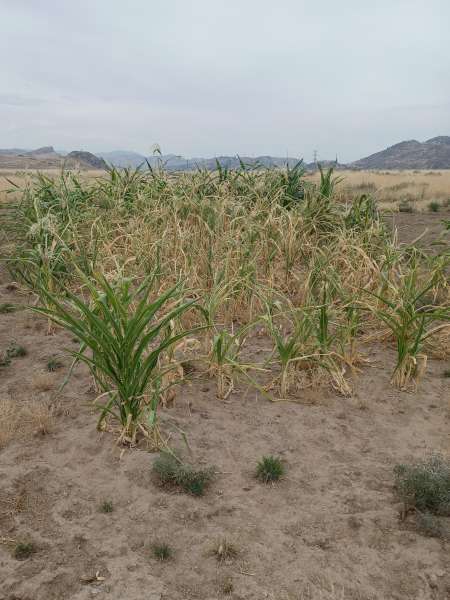
Concha White / Square Dry In Middle
|
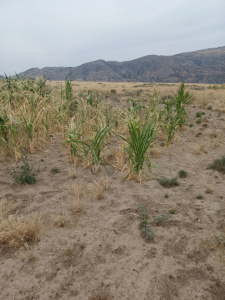
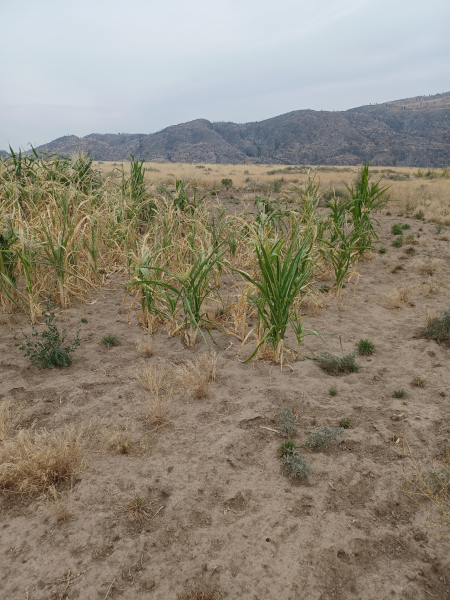
Concha White / Green South Edge
|
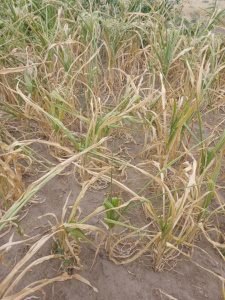
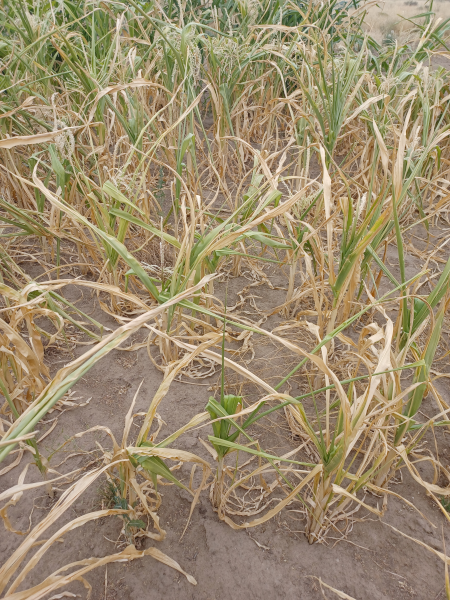
Dry Middle / Green North Edge Behind
|
What is the Best Planting Arrangment for Hopi Corn?
Hopi plant in blocks 3-5 paces apart. A search engine result says to plant in blocks 4.9-5.7 feet apart, but I can find no scientific papers or sources to support this spacing. In videos by Michael Kotutwa Johnson the hills look to be 7-10 feet apart and in one case he used a tractor to plant in 6 foot rows. In another video the farmer took 3 long paces and then used a hoe to make a hole 3 feet further or 4 paces / 12 feet between hills. Akima plants in hills, thinned to 4-7 plant per hill, 3 paces by 3 paces apart with hills staggered so hills in a row are midway between hills of adjacent rows. In another video Akhima says "4 steps in between" with 4-7 plants per hill. This comes out to between 11.57 - 36 sq. ft. per plant. The Collins paper has pictures of hills 20 feet apart with 10 - 20 plants per hill which is 20 - 40 sq. ft. per plant. The average of 11.57 and 40 is 25.8 sq. ft. per plant. This is a much lower plant density than the 2 ¾ and 3 ¾ sq. ft. per plant we used in 2023 and 2024 respectively. Planting multiple seeds in a hill compensates for losses due to pests or disease, and if the weakest seedlings in a hill are not removed the ears will be short and of low quality (Akhima). Most Hopi varieties we have tried develop multiple stalks from tillers and can produce up to 8 ears per plant so 4-7 plants per hill may not be necessary. Conversely more plants per hill may inhibit tiller formation resulting in a similar number of stalks per hill. Optimal spacing for a given location will depend on soil type, ground moisture, and local weather conditions.
In windy areas planting hills more than 12 feet apart may increase erosion since the distance between hills is more than 3 times the plant height. Take into consideration that during the first part of the growing period plants are not full height. Rows 5-6 feet apart perpendicular to the wind with 3-5 feet between plants in a row is a good option if planting individually.
We are still in the process if determining optimal spacing for Hopi Corn but our own results suggest that more than 8 square feet per plant is needed. Hopi plant with 11.57 square feet per plant or more, usually around 20-25 square feet per plant. A hexagonal latice arrangement (plants are planted at vertices of equilateral triangles) is optimial, eg. the highest density with equidistant planting. See next section for discussion of hexagonal lattice. You can use our corn spacing and yield calculator below to try out different planting arrangements and densities.
Try Our New 2025 Corn Spacing & Yield Calculator
Hopi Agriculture - Dry Farming Techniques by Michael Kotutwa Johnson (2014)
What Planting Arrangement Minimizes Competition but Maximizes Density?
A hexagonal lattice. Plants growing next to each other compete for water, nutrients, and light and inter-plant competition so important that millions of dollars are spent on precision seeding equipment and herbicides every year. To maximize density and reduce competition between plants, plants need to be of equal distance from each other (equidistant). The corners of an equilateral triangle are equidistant and 6 equilateral triangles can be arranged in a hexagon resulting in optimal density and all plant distances being equal. If you arrange similar diameter pots as close as possible the resulting arrangement is the same. This means that if plant spacing within a row is 1 (foot or meter) then the distance between rows is 0.866 (feet or meters). Multiply plant spacing by 0.866 to get row spacing and offset rows by half which results in rows being narrower than distance between plants. This arrangement increases planting density by 15% with the same planting distance.
Where did we get 0.866? Divide an equilateral triangle in half. Get the area of half using a^2 + b^2 = c^2. c=1 and b=0.5 so a^2 = 1 - 0.25 = 0.75. The square root of 0.75 is a=0.8660254. Which is the distance from the middle of one edge to the opposite vertex and the row distance.
To assist in planting make an equilateral triangle tools of the right side and use one side to measure distances in a row with the tip of the triangle the location of the plant in the adjacent row.
How to Manage Weeds for Dryland Hopi Corn?
Research shows that weed control is most effective when weeds reach 4 - 5 inches high and when weed control is delayed corn yield can decrease as much a 3 bushel/acre per day. The effect of weeds on corn yield decreases after corn reach V6 stage (6 leaves).
In our 2023 and 2024 experiments we did not have a big problem with weeds but in 2025 we had major losses. We have 3 observations from our 2025 experiments. 1) Weeds are worse in areas that were previously cultivated, in 2023 and 2024. 2) We used a cultipacker on all fields in 2025 which increased weed seed soil contact and germination rates. 3) We had an early warm spell, an early spring rain, and tilled early (not close enough to planting time) giving the weeds a head start.
In 2025 we used the cultipacker to firm the soil and decrease moisture loss but this also increased weed seed soil contact and weed germination rates. Retrospective overservation is that fields that were trenched then filled with the rebar harrow in 2023 and 2024 seemed to have fewer weeds than fields that were tilled then packed with the cultipacker. To realize the benefits of using a cultipacker, improved weed management is necessary.
We noticed that cheatgrass has a major effect cause corn to turn yellow, dry out, and fail to thrive. Other serious weeds include lambsquarters and in one area lemon balm smothered the corn seedlings. To a lesser extent prickly lettuce, dryland goosefoot, mustard, and tumble mustard visibly slowed the growth of corn.
Planning for weed control is very important so plant such that tilling operations can be done between the rows of corn without damaging the corn itself. We tried pulling weeds, a grub hoe and a weed whacker with a blade and all of these methods were labor intensive. The grub hoe is probably the most effective since it doesn't require bending down, risk to corn stalks in reduced, and weed roots can pulled out or severed below the ground. The weed whacker only cuts off the tops of weeds and easily strays and can easily damage the corn stalks especially where corn is planted closely like 3ft. x 3ft. Weeds close to the corn stalks need to be pulled by hand.
Our tiller is 5' wide so in 2026 we'll use the tractor wheels to mark out rows 6.5 feet wide and till between the rows to control the weeds. Hills spacing will be in 6.5 foot rows with 3 - 6.5 feet between plants. After the topsoil dries out, tilling is not advised because it generates dust, but dry topsoil also hinders weed germination. Tilling should be done early in the season while the top layer of soil still retains some moisture and just as weeds are taking hold, 2-6 inches high.
Here is a list of the most troublesome ones that are either prolific seed producers or hard to remove. Cheatgrass and Lambsquarters are two of the worst. Lambsquarters and Aridland Goosefoot are related but Lambsquarters is much hard to pull out from the root and both make many seeds.
- Cheat Grass, grasses spp. (aggressive seeders, very competitive)
- Lambs Quarters (aggressive seeder, very competitive, deep rooted difficult to remove)
- Lemon Balm (aggressive seeder, very competitive in certain areas)
- Rush skeletonnweed (very competitive in certain areas)
- Prickly Lettuce (aggressive seeder, prickly with sticky sap)
- Aridland Goosefoot (aggressive seeder, not as competitive, not as deeply rooted)
--- below are less troublesome for this year --- - Witchgrass (aggressive seeder)
- Tar Weed (aggressive seeder, prickly)
- Tumble Weed (aggressive seeder,prickly)
- Red Root Pigweed (aggressive seeder)
- Scotch Thistle (aggressive seeder, prickly)
- Tumble Mustard (aggressive seeder)
- Mustard (aggressive seeder)
- Diffuse Knapweed (aggressive seeder. prickly)
- Dandelion (aggressive seeder, deep tap root but relatively easy to remove)
- Baby's Breath (aggressive seeder, perennial, control by tilling)
- Lupine (control by tilling)
Our tractor tiller is 5' wide so in 2026 we'll use the tractor tires to mark out the field and plant in rows 6.5 feet apart. We will try both 6.5 x 6.5 foot hill planting as well as 6.5 foot rows with 3-4 feet between hills and use the tiller to manage the bulk of the weed problem.
What are the Yield Estimates for Dryland Hopi Corn?
Our biggest mistakes have been planting too closely and focusing on yield per acre. If a large area of unused arid land is available for planting (take land area out of the equation) then increasing yield per resources and labor inputs becomes the main objective, not yield per acre. Yields are understandably less than expected compared to an in a irrigated field. An ear of corn can have between 0.25 and 0.8 lbs of kernels and irrigated Navajo corn produces an average 0.95 lbs per plant. One acre 43560 sq. ft. / 25 = 1742.4 plants per acre X 0.95 = 1655 lbs / 56 = 30 bushels. This is only an estimate and yield could be higher or lower based on several factors, but it seems reasonable optimized spacing could yield 30 - 50 bushels per acre since dryland wheat yields 42 bushels/acre in Washington State.
How Much Yield Is Needed To Sustain A Person Or A Family?
To get an idea what 1 person would need, or a family, we'll make some conservative estimates assuming a person needs 2800 kcal. per day and 35% of the diet is meat/eggs/dairy, with 10 times more carbohydrates needed to sustain the livestock. The human diet needs a certain amount of fat and protein (eggs, meat, fish, or dairy) can be provided for my chickens, pidgons, goats, rabbits, or other manageable farm animals. I'll also assume no other expenses such as fuel for tractor, etc. So this comes out to 1820 + 9800 or 11620 kcal. This may be on the high side so assume the extra is sold or traded for other needed commodities. 11620/(4 kcal/gram)/(453.6g/lb.) = 6.4 pounds a day with most of it being animal feed. That is 36 bushels or less annually with the bulk of that being used as livestock feed. Assuming 36 bushels of corn per acre, each person would need an acre. If full time is dedicated during planting and harvest 1 person can easily manage an acre of low density planting. The bulk of the labor is clearing, soil preparation, and plowing. Labor saving tools such as tilling or plowing equipment and a drill with an augur attachment will reduce fatigue and speed up the tasks. A nitrogen rich legume crop can be added into the rotation to produce a protein rich food for livestock and as a source of vitamin B3 which is not readily absorbed from untreated corn. In total 20 acres with less than 12 inches of rainfall should be able to produce much more than enough for a 5 person family.
How Labor Intensive is Planting Hopi Corn?
Traditional Hopi farming relies on manual "labor intensive" methods, and we have tried different planting methods to increase yield and decrease resources and manual labor needed to grow Hopi corn. A tractor can be used for clearing, spreading fertilizer, tilling in fertilizer, making a trench to plant, and backfilling. Without specialized tractor equipment, deep planting and thinning must be done manually. For manual planting, we use a drill with a garden augur, and it significantly reduces the time and effort needed to plant. Also, planting manually in hills farther apart requires about the same effort (bending down and digging) per hill as planting hills close together and may improve per hill yield. Planting multiple seeds in hills ensures some will emerge in each location and requires less effort than planting individually. Excluding field preparation, it take about 20 man hours to plant an acre of Hopi Corn using 6' x 6' hill spacing with a drill and augur attachment (2025 results).
What are the Benefits of Planting Corn in Hills?
Planting in hills reduces the labor needed to grow and harvest corn. Planting corn individually means it is necessary to bend down, make a hole, plant seed singly, and later thin and harvest plants individually. Planting in a hills makes it possible to plant and tend several plants at the same time, eg more yield for less effort. It is also advantageous since plants within a hill can support each other and reduce lodging in windy areas, though it may also lower per plant yield due to increased competition for water and nutrients.
Some Hopi farmers plant from a bowl where seeds from different ears are combined while others take seeds directly off an ear and put these in one hill. This will have an effect on genetic distribution that is not obvious initially. In the first case every hill is planted with kernels from different parent plants and traits will be averaged out or diluted. If seeds in a hill are planted directly from the cob, all progeny plants in a hill and nearby hills come from the same parent and they will all be somewhat similar. Ears from a hill have a slighly higher likelyhood of being pollinated by plants in the same hill and nearby hills (which may also have been planted from the same ear). In the next year a cob is taken with all the hills nearby again providing pollen with even less diversity intensifying any traits in the original parent. Corn cross pollinates readily over distance so inbreeding depression is not likely but planting in this way will amplify desirable characteristics assuming only seeds from plants with desirable traits are planted. The overall effect is to amplify traits hastening the process of artificial selection and strain improvement. It is similar to selecting seeds with desired traits and planting them in a separate field to create a new variety. This would be something I might try if I had an ear with unusually pretty colors that I wanted to get more of the next year but not yet isolate from the general population.
How Much Fertilizer is Needed for Dryland Hopi Corn?
The roots of corn plant extend up to 10 feet around each hill to reach water and nutrients, and broadcast fertilizer recommendations need to be adjusted to compensate for plant density and removal of nutrients by the crop. In Georgia dryland corn is planted 16000-18000 seeds per acre, but the average annual rainfall in Georgia is 50 inches and dryland yield can be more than the national average for irrigated corn. The suggested fertilizer rates for dryland corn in Georgia are 120-80-80 lbs. per acre, assuming a yield of 100 bushels/acre. Since Hopi corn is typically grown at at 10 times lower plant density with much less rainfall, fertilizer rates need to be adjusted for expected yield.
Our supplier doesn't have and won't mix in Iron or Magnesium, and Zinc is either included in MESZ, added separately, or not at all. If our supplier does not have 1152 I use MESZ. Adjust the values below for the size of your field. It is a good idea to get a soil test and only add the "other supplements" if needed. We use more K20 than the 120-80-80 recommended by UGA.
Previously we calculated an expected yield as 30 bushels per acre which is not far from 42 bushels per acre for wheat. Optimistically assuming dryland Hopi corn planted with optimal spacing can make 50 bushels per acre, fertilizer should be reduced by half and an application rate of 60-40-40 lbs per acre should be sufficient to maintain the crop. If planting fallow or previously uncultivated land, we recommend using the amounts below for the first year to determine the maximum yield when fertilizer is not limiting and then reducing the amounts in subsequent years by multiplying the values below by the first year yield in bushels/acre divided 100 (the fertilizer rate for dryland corn in Georgia assuming expected yield of 100 bushels/acre). So for example if first year yield is 30 bushels then 120lbs of Nitrogen x 30 bushels/100 bushels = 36lbs of Nitrogen for the second year.
| Fertilizer for 1 acre of corn using 1152 assuming 100 bu/acre | |
|---|---|
| 225 lbs Urea 46-0-0 | N 103.5 lbs/acre |
| 150 lbs 1152 11-52-0 | N 16.5 lbs/acre + P205 78 lbs/acre |
| 166 lbs KCl MOP 0-0-60 | K2O 99.6 lbs/acre |
| 18 lbs MnSO4 28% | Manganese 5 lbs/acre |
| Boron Coating | - added by supplier - |
| Nitrogen Stabilizer | - added by supplier - |
| Fertilizer for 1 acre of corn using MESZ assuming 100 bu/acre | |
| 208.7 lbs Urea 46-0-0 | N 96 lbs/acre |
| 200 lbs MESZ 12-40-0-10-1 | N 24 lbs. - P205 80 lbs. - Zn 2 lbs. |
| 166 lbs KCl MOP 0-0-60 | K2O 99.6 lbs/acre |
| 18 lbs MnSO4 28% | Manganese 5 lbs/acre |
| Boron Coating | - added by supplier - |
| Nitrogen Stabilizer | - added by supplier - |
| - other supplements to add once or if soil tests low - | |
| 52 lbs FeSO4 31% Iron Monohydrate | Iron 16 lbs/acre |
| 30 lbs Zinc Sulfate 35% Zinc | Zinc 10 lbs/acre if not using MESZ |
| 50 lbs MgO 45% Magnesium Oxide | Magnesium 22.5 lbs/acre (*50-100) |
Hopi Corn - Seed Preparation / Pre-Sprouting
If planting by hand it is best to soak the corn seeds before planting. Seeds should be soaked at least 8 hours before planting. Old seeds may be dry and benefit from multiple soak/rest cycles. Soaking more than 12 hours can damage seeds due to a lack of oxygen so it is better to soak 8-12 hours, drain, rest 8-12 hours, then soak again 8-12 hours, and repeat until roots begin to develop but are not extending from the kernels. Seeds which are too far along in the germination process and have emerging roots are easily damaged by handling. It is best to discard floating seeds which may not germinate and it is better to plant soaked seeds right away as refrigeration can damage soaked seeds. We soak our seeds overnight, drain in the morning, rest for 8-10 hours covered with a damp paper towel, and plant in the evening.
If seeds are not soaked, plant deep enough to reach moist soil and replace moist soil on top of the seeds followed by drier soil.
Are Floating Seeds Inviable?
No, this is a myth. While in general it is believed that seeds that float are less likely to germinate, floating seeds may also germinate. Seeds may have air pockets or a less permeable seed coat, and the only way to tell if a seed will germinate is to plant it or do a germination test.
Corn Kernel Size & Shape Does Affect Seedling Vigor
Corn from smaller seeds have a reduced rate of emergence and are weaker during the vegetative stage especially when planted deeply, in cooler soil, or under water stress. Under favorable irrigated condition and given enough time corn plants from small kernels catch up to the plants from large kernels with little difference in final yield. Corn grown from large flat kernels in the middle of the ear are more vigorous. Large kernels germinate faster and have a higher percentage of germination under stressful conditions and do better during the early stages of growth. The differences in germination and development due to kernels size are more significant with increased planting depth and cooler soil temperatures. We plant Hopi Corn very deep, 8 inches deep, compared to the conventional planting depth of 2-3 inches. In North Central Washington we must plant our corn as early as possible while soil temperatures are still cool so the kernels will mature and dry down before the first frost in the fall. Our best producing plants seem to have noticably larger kernels. Each year we have selected kernels from the best producing plants for the next year, and as a result kernel size and weight seem to be increasing. Larger kernels will allow plants to develop a strong root system earlier before suface water evaporates or infiltrates deeper into the ground and before the hottest days of summer.
Research shows that although round seeds at the butt of the ear are heavier flats from the middle of the ear are more vigorous and the article catagorized large seeds in ounces per 100 kernels which when converted was 0.28 g per kernel. We find that frequently cobs with larger kernels were from "Super Producers" and / or a cross of 2 different varieties of Hopi corn (eg Hopi Blue x Hopi White) and some like Hopi White - Grape have kernels frequently heavier than 0.40g. In 2025 we pooled kernels over 0.35g and the largest flats from "Super Producers" for planting. The hypothesis that larger kernels increases production still need to be tested further and we'll continue selection for larger kernels and do more experiments to confirm the idea.
How Deep To Plant Dryland Hopi Corn?
Plant Hopi Corn 6 - 8 inches deep or deep enough to contact moist soil. Hopi corn is adapted to deep planting and deep planting helps seeds absorb enough water to reach the soil surface and later reduces lodging. In 2024 emergence was poor when planting single seeds deeper than 12 inches, and in 2025 emergence was poor when we drilled holes 10 inches deep and planted 3 kernels per hole. Under our conditions planting deeper than 8 inches is not beneficial, and deep planted seedlings are initially weaker than shallow planted seedlings. Scientific research has shown that this difference in deep vs shallow planted corn disappears before tassel formation, and that deeply planted corn better tolerates hot/dry weather. If planting deeper than 6 inches (to reach moist soil), use the hill method with 10 or more seeds per hill and later thin to desired density.
How To Plant Dryland Hopi Corn?
Till the soil to remove all competing vegetation, spread fertilizer, and till in the fertilizer in before planting. Loose tilled soil looses water more quickly so use a cultipacker to firm the soil before planting. Make a hole 6 to 12 inches deep and deep enough to reach moist soil. If the surface is dry it is best to scrape a clear area, remove the soil by hand, plant 7-10 kernels, and place the moist soil back in the bottom of the hole with the top dry soil back on top. We use a 2 inch augur with a drill and drill an 6-8 inch hole, plant the seeds, and push the soil back in the hole. To ensure that holes don't collapse before seed placement and no holes get missed, it is better if one person drills the holes and a second follows behind planting seeds. Push the soil with a shoe or hoe to cover promptly reducing soil evaporation and the chance that exposed seeds will be eaten by wildlife. If using an augur and doing many hills an extension cord drill will work better than a battery powered drill. Our battery powered drill can do 40-100 holes per charge depending on battery size. If power is available use as many 100 ft. light duty extension cords as needed to reach planting areas. Consider using a generator or solar generator for power. The drill will get hot after about 400 holes and needs time to cool down or alternate with another drill. After planting do not drive a tractor directly over planting holes. It is beneficial to water each hole sparingly if the soil is very dry.
If planting in furrows with a tractor, a middle buster can be used to make a 12 inch furrow and corn planted at the bottom of the furrow. Plant only one row in the middle of the furrow either singly or in hills at the desired spacing. Pull a rebar harrow behind the tractor to fill in the furrows by driving on the high parts on each side of the furrows. Make sure to make enough passes and put the tines on the harrow down for at least 1 pass to get adequate coverage. A cultipacker can be used to firm the tops of the furrows. If furrows are not well filled, soil moisture loss will be higher, plants root structure will not be as strong, and plants will be more easily toppled by wind or rain.
How to Thin & Hill Dryland Hopi Corn?
When the corn is 8-12 inches tall remove a couple inches of soil around the plants in each hill and remove the weakest leaving 4-7 plants per hill. After thinning pull surrounding soil back around the stalks and firm the soil. If corn was planted in a trench or depression move soil to fill in the depression and as the corn gets taller hill extra soil around the base of the stalks. The extra soil provides extra support and acts as an inorganic mulch to reduce evaporation.
How to Mulch Dryland Hopi Corn & What is Dust Mulching?
Mulching help keep soil cool, retains moisture, and helps prevent weed growth. Most people use various natural or synthetic materials to mulch but this isn't practical on a large farm unless specialized equiment is available or it is composed of natural organic materials already in the field. For our conditions we just don't have enough organic matter yet to use for mulch so we dry/dust mulch.
I'm not sure if dry mulch, sand mulch, or dust mulch are new terms but we have used sand/soil to mulch. You might be asking, "what?", isn't that the same as planting deeper? Yes and no. In 2024 we made trenches in the south field and planted with the augur at the bttom of the trenches and did not fill in the trenches. After the corn and sorghum reached 2 - 3 feet high we kicked in the dirt around the plants effectively making the soil deeper around the roots and reducing heat and moisture loss in the root zone.
In 2025 we planted several hills of Hopi Grey Squash and dug a hole 5 inches deep and planted the whole hill of squash deeply below the level of the soil. As the squash grew we filled in the hole. In July they started wilted little when temperatures got up to 106°F heat. At first we were going to dig a shallow trench and bury the vines and encourage additional root growth but the vines were too short and stiff to bend, at least in the early morning. So instead we took surrouding dirt/loam and covered the center are of the plants and as much of the vines as possible leaving the leaves and new tendrils sticking out. As they get bigger we continued this process. We'll keep you updated on our squash page!
Hopi Corn Pests & Diseases
Grasshoppers, birds, and rodents can damage corn and reduce yield. Tilling kills grasshopper eggs in the soil. For organic control of grasshoppers spread a 4 foot band of diatomaceous earth with a flour sieve around the field and between every 4 rows. Grasshoppers hop onto the treated areas and they will die after a few days. For a smaller plantings put screen sleeves over the tops of the ears which allows pollination but prevents grasshoppers from eating the silk, though in theory silk will continue to elongate until pollinated. The screen can be left on to reduce damage by birds. Birds peck through the husk at the top of ears but usually only part of the ear is damaged. For rodents mouse traps with peanut butter are effective. Corn smut is a fungal disease that causes kernels to become enlarged and grey colored. It can infect several types of corn with some varieties being more susceptible than others. While some farmers consider corn smut a loss, it is cultivated in Mexico and eaten as a delicacy called Huitlacoche.

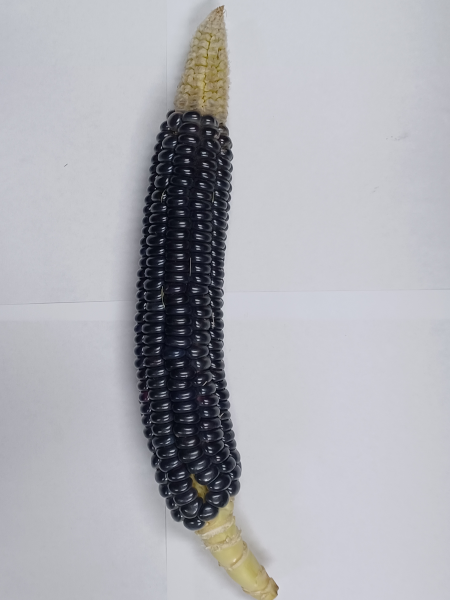
How to Harvest & Store Hopi Corn?
Hopi Corn can be harvested at the immature milk stage for eating fresh like sweet corn when the silk has turned brown. If harvested too early the kernels will not be as sweet or fully developed and if too late will be slightly starchy. For sweet Hopi Blue corn harvest when the tassels are brown but the kernels are still completely white. As soon as it develops a tinge of blue, it turns from sweet to starchy.
If planning to store the corn or use it for seed leave it as long as possible on the stalk or until the husks are dry. Mature corn that has already bent in a downward direction is usually ready to harvest. Discarding some of all of the husks in the field reduces work later and provides mulch for next years crop. Bend the ear down till it snaps off. Then break it again below the last row of kernels. Husks attached below the break point will stay with the stem and the remaining ones are easily removed. Discard the silk. If harvested early the silk will be green and fresh, and it may be better to wait longer before harvesting ears with simliar appearance.
Immature corn kernels will have a lower germination rate. Hopi Blue Corn that is dark or medium blue should have greater than 90% gerimination rate while lighter colored less mature blue corn will have a germination rate of 75% or lower. For long term storage allow corn to dry in the field till moisture is less than 15%. Corn will dry rapidly when temperatures are high and humidity is low but decreases to 0.4% percentage points per day when average daily temperature is 55°F. Corn that is not yet dry on the stalk can be damaged by freezing temperatures resulting in decreased seed viability. Late harvested corn can be brought indoors finish the drying process. If moisture higher than 15%, it is better to dry it on the cob with ventilation or mold could grow decreasing the viability of the kernels.
How to Treat Corn Seeds to Prevent Mold?
Corn moisture content should be reduced to 15% for short term storage or lower for long term storage. If the corn is not dry enough before storage it will develop mold or sprout decreasing it's viability. The best option is that the corn dries on the stalk in the field before harvest since this doesn't require extra effort and energy. The next best option is to leave it on the cob and store with plenty of ventilation above freezing. Corn will loose about 0.5% moisture per day at 60°F but this can increase to 1% per day at higher temperatures. Do not treat corn seeds at temperatures above 110°F or this can decrease viability.
Corn from 2024 harvest was put in open 3 or 17 gallon plastic bins or piles of corn at 40-65°F or a "plant" room at 60°F. Some of the corn was not dry enough because 20 days later some were sprouting and growing mold, Also, storing boxes of corn in a warm reatively humid "plant" room next to my orchid grow tent exhaust wasn't ideal. I found out some of the ears at the bottom of the bins near the exhaust were sprouting and molding. The corn in the top 2/3 of the bins was generally unaffected.
The damaged ears were separated or discarded. Some of the ears were spread out on the floor with convections heaters and others were treated in a dehydrator. The dehydrator was put on the lowest setting at 105°F with 2 batches of corn each swapped 12 hours on 12 hours off for 5 days. After treatment, the germination rates of "good" and "slightly molded" corn seeds were 95% and 90% respectively. Dehydration treatment at 105°F did not significantly reduce germination rate.
What Cover Crops To Use For Dryland Hopi Corn?
Hairy Vetch is legume cover crop that will add nitrogen to the soil, and it grows well during fall and spring when temperatures are cool. Plant in the fall after harvesting corn and kill the following spring by crimpling or tilling before planting corn in May.
Dryland Hopi Corn 2025
Dryland Hopi Corn 2024
Dryland Hopi Corn Experiment 2023
Winter Wheat Planting 2023
Sorghum